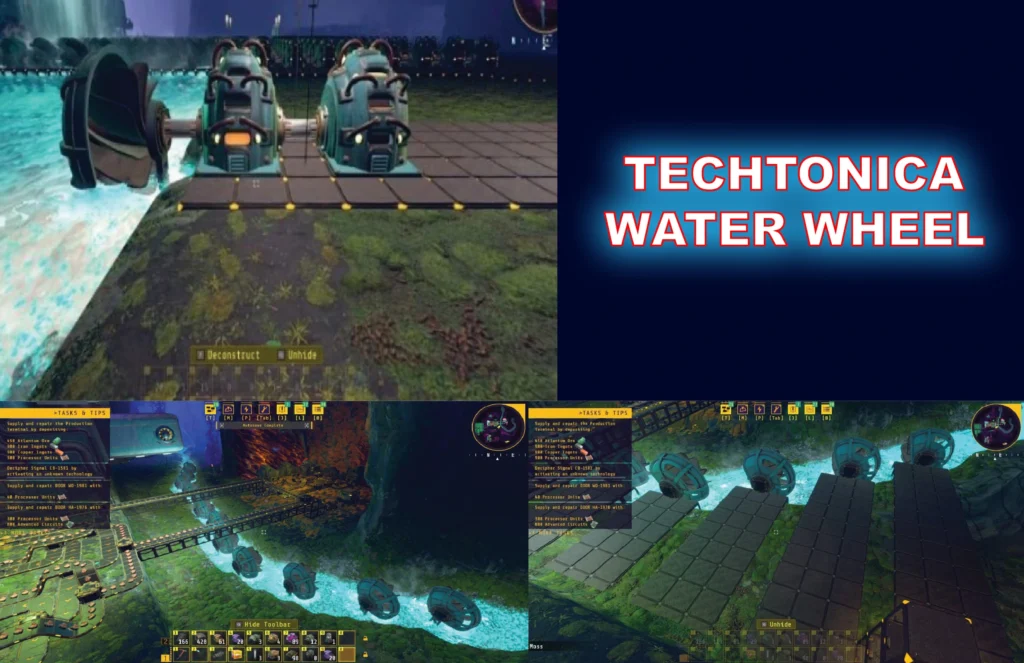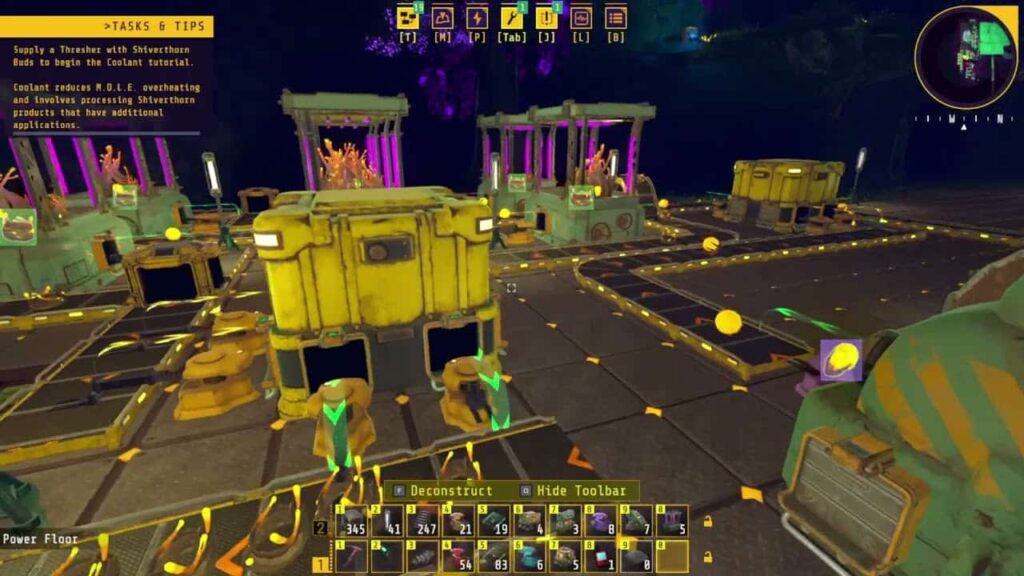In the vast, resource-rich world of Techtonica, the quest for sustainable energy sources is paramount.
Techtonica’s water wheel system offers renewable energy generation through strategically placed water wheels, providing power for various base operations.
This guide explores the intricacies of unlocking, constructing, and optimizing water wheels within the game.
Unlocking Water Wheels:
To harness the power of water wheels, players must first locate them north of Terminal Victor.
However, access to this renewable energy source requires Terminal Victor to reach level 2 and invest 180 purple research points. Once these prerequisites are met, players can scan the water wheels in the river, paving the way for their utilization.
Construction And Functionality Of Techtonica Water Wheel:

1. Placement Options:
Water wheels can be strategically placed in any body of water across the game world. This flexibility allows players to harness the power of rivers, lakes, or even artificial reservoirs within their bases.
2. Power Generation Mechanics:
The operation of water wheels revolves around their interaction with cranks. A single water wheel can accommodate up to 2 Mark 1 Cranks, while two water wheels can sustain a single Mark 2 crank. This relationship determines the amount of power generated by each setup.
3. Impact Of Additional Cranks:
It’s essential to recognize that adding more cranks to a water wheel without corresponding increases in water wheels can lead to diminishing returns.
Overloading a single water wheel with cranks can reduce power output. Thus, players must carefully balance the number of cranks with the available water wheels to optimize energy generation.
4. Factors Influencing Efficiency And Optimization:
Several factors influence the efficiency of water wheel setups. These include the type of cranks used, the placement of water wheels relative to cranks, and the overall design of the power network within a player’s base.
Read: How To Find Sony Speaker Zma Files – Guide!
Breaking Down The Process:

1. Construction Requirements:
Water wheels require specific construction materials:
Five iron frames
20 mechanical components
20 electrical components
Additionally, the raw material costs include:
26 copper ingots
57 iron ingots
These materials are essential for crafting each water wheel, providing structural support and functional components.
2. Crafting Time:
The construction of water wheels takes time, with each wheel requiring 45 seconds of handcrafting.
However, players with unlocked Craft Speed IV can significantly reduce this time to 9 seconds per wheel. This efficiency gain allows for faster deployment of water wheel systems within a player’s base.
3. Power Output:
Understanding the power output of water wheels is crucial for optimizing energy generation. Mark 1 cranks, commonly used with water wheels, generate 300 kW of power per wheel.
In contrast, Mark 2 cranks offer a higher output of 400 kW per wheel. This distinction influences players’ decisions when designing their energy infrastructure, as they seek to maximize power output while minimizing resource expenditure.
4. Module Power Consumption:
In addition to power generation, players must consider the power consumption of modules connected to water wheel systems. Mark 2 assemblers, mining drills, and threshers each consume varying amounts of power:
Mark 2 assemblers: 300 kW
Mark 2 mining drills: 900 kW
Mark 2 threshers: 1200 kW
These consumption rates inform players of the energy requirements associated with different modules, allowing for more efficient allocation of resources and optimization of power networks.
5. Automation:
Players can automate the process using assemblers to streamline the production of water wheels.
By setting up automated production lines, players can ensure a steady supply of water wheels for their energy systems.
This automation frees up valuable time and resources, allowing players to focus on other aspects of base management and expansion.
6. Efficiency And Optimization:
Ultimately, the detailed breakdown of water wheel construction and functionality guides players seeking to optimize their energy infrastructure in Tectonic.
By carefully managing resources, maximizing power output, and automating production processes, players can create efficient and sustainable energy systems that support the growth and development of their bases.
Optimizing Water Wheel Systems In Techtonica:

1. Crank Selection:
Choose the appropriate crank type based on your energy needs. While Mark 1 cranks are efficient, consider upgrading to Mark 2 for higher power output and potential space savings.
2. Water Wheel Placement:
Strategically position water wheels within your base to maximize power generation. Experiment with different locations to find the optimal setup for your terrain and water flow patterns.
3. Module Integration:
Integrate water wheel systems seamlessly with other modules and structures in your base. Consider the power consumption of connected modules such as assemblers, mining drills, and threshers, and adjust your water wheel setup accordingly to meet these demands.
4. Automation And Production Efficiency:
Utilize automation to streamline the production of water wheels and other components. Set up automated production lines using assemblers to ensure a continuous supply of water wheels for your base.
Invest in production efficiency upgrades and optimize production processes to improve overall efficiency.
5. Expansion And Scaling:
Plan for future expansion and scaling of your water wheel systems. Anticipate increasing power demands as your base grows and evolves, and design your energy infrastructure accordingly. Implement scalable solutions allowing easy expansion and adaptation to changing requirements over time.
6. Resource Management:
Manage your resources effectively to ensure the sustainable operation of your water wheel systems.
Monitor resource consumption and production rates, and adjust your strategies accordingly to maintain a balanced supply of materials. Consider recycling and repurposing materials whenever possible to minimize waste and optimize resource utilization.
Read: Blink Camera Blinking Green – Unlock All Information!
Conclusion:
In conclusion, optimizing water wheel systems in Techtonica requires careful planning and consideration of various factors such as crank selection, placement, module integration, automation, expansion, and resource management. By implementing these strategies effectively, players can create efficient and sustainable energy networks that support the growth and development of their bases while minimizing environmental impact and resource consumption.
Related Questions:
1. How Do I Unlock Water Wheels In Techtonica?
Water wheels can be unlocked by scanning the river north of Terminal Victor. Ensure that Terminal Victor is at level 2 and has 180 purple research points available for unlocking.
2. What Materials Are Required To Construct Water Wheels?
To construct water wheels, you will need five iron frames, 20 mechanical components, and 20 electrical components. Additionally, you’ll need 26 copper ingots and 57 iron ingots for raw material production.
3. What Is The Difference Between Mark 1 And Mark 2 Cranks?
Mark 1 cranks generate 300 kW per wheel, while Mark 2 cranks offer a higher output of 400 kW per wheel. Mark 2 cranks may be preferable for their increased power output and potentially greater space efficiency.
4. How Should I Optimize My Water Wheel Setup?
Optimize your water wheel setup by strategically selecting crank types, placing water wheels in optimal locations, integrating them with other modules, automating production, planning for expansion, and managing resources efficiently.
5. Can Water Wheel Production Be Automated?
Yes, water wheel production can be automated using assemblers. Set up automated production lines to ensure a steady supply of water wheels for your base, freeing up time and resources for other tasks.
6. What Should I Consider When Expanding My Water Wheel System?
Consider future power demands, scalability, and resource availability when expanding your water wheel system. Plan for easy expansion and adaptation to accommodate changing requirements as your base grows and evolves.
Read:
